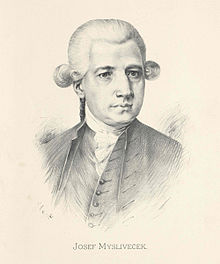Ezio (Mysliveček, 1777)

Ezio is an eighteenth-century Italian
Performance history
The opera was first performed at the
Roles
| Role | Voice type | Premiere cast, 10 January 1777, Hoftheater, Munich |
|---|---|---|
| Valentiniano III, emperor of Rome, in love with Fulvia | soprano castrato | Tommaso Consoli |
| Fulvia, daughter of Massimo, a Roman patrician, in love with Ezio and betrothed to him | soprano | Angela Gallieni |
| Ezio, general of the imperial armies, in love with Fulvia | soprano castrato | Luigi Marchesi |
| Onoria, sister of Valentiniano, secretly in love with Ezio | soprano | Rosa Manservisi |
| Massimo, Roman patrician, father of Fulvia, confidant and secret enemy of Valentiniano | tenor | Domenico de Panzacchi |
| Varo, prefect of the Praetorian guard, friend of Ezio | tenor | uncertain ("Il Sig. N.N.") |
Vocal set pieces
Act I, scene 2 - Aria of Valentiniano, "Se tu la reggi al volo"
Act I, scene 3 - Aria of Ezio, "Pensa a serbarmi, o cara"
Act I, scene 4 - Aria of Fulvia, "Caro padre, a me non dei"
Act I, scene 5 - Aria of Massimo, "Il nocchier che si figura"
Act I, scene 7 - Aria of Onoria, "Quanto mai felici siete"
Act I, scene 9 - Aria of Valentiniano, "So chi t'accese"
Act I, scene 11 - Aria of Ezio, "Guarda pria"
Act I, scene 12 - Aria of Fulvia, "Finche un zeffiro soave"
Act II, scene 3 - Aria of Valentiniano, "Vi fida lo sposo"
Act II, scene 4 - Aria of Massimo, "Va, dal furor portata"
Act II, scene 6 - Aria of Ezio, "Recagli quell'acciaro"
Act II, scene 7 - Aria of Fulvia, "Quel fingere affetto"
Act II, scene 8 - Aria of Varo, "Nasce al bosco in rozza cuna"
Act II, scene 10 - Aria of Onoria, "Finché per te mi palpita"
Act II, scene 13 - Quartetto "Ecco alle mie catene"
Act III, scene 1 - Aria of Onoria, "Peni tu per un'ingrata"
Act III, scene 2 - Aria of Valentiniano, "Con le procelle in seno"
Act III, scene 5 - Rondò of Ezio, "Mi dona, mi rende" [a non-Metastasian text]
Act III, scene 10 - Aria of Massimo, "Tergi l'ingiuste lagrime"
Act III, scene 11 - Aria of Fulvia, "Ah, non son io che parlo"
Act III, scene 13- Coro "Della vita nel dubbio cammino"
Act III, scene 14 - Chorus, "Della vita ne' dubbio camino"
See also
References
- ^ Documentation concerning the Munich performance of Mysliveček's Ezio of 1777 is found in Daniel E. Freeman, Josef Mysliveček, "Il Boemo" (Sterling Heights, Mich.: Harmonie Park Press, 2009). More detailed information is found in German in Karl Böhmer, W. A. Mozarts "Idomeneo" und die Tradition der Karnevalsopern in München (Tutzing, 1999), pp. 84-87.
